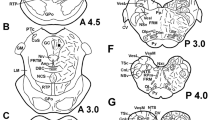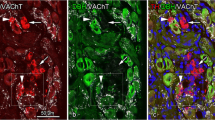Summary
Using immunoelectron microscopy to observe the distribution of substance P-positive nerve terminals in the superior cervical ganglion of the rat, the authors found that the substance P-containing nerve terminals appear in the neuropil or around the perikarya of the principal neurons and form symmetrical axo-somatic synapses with the body of the principal neurons. Morphological features described suggest that substance P might play a certain role in regulating sympathetic function.
Similar content being viewed by others
References
Sternberger LA. Immunocytochemistry. New York; Wiley, 1979: 104–69.
Chan-Palay V, Palay SL. Ultrastructural identification of substance P cells and their processes in rat sensory ganglia and their terminals in the spinal cord by immunocytochemistry. Proc Natl Acad Sci USA 1977; 74: 4050–4.
Henry JL. Substance P and pain: a possible relation in afferent transmission. In: Von Euler US, eds. Substance P. New York; Raven Press, 1977: 231–40.
Author information
Authors and Affiliations
Rights and permissions
About this article
Cite this article
Chang-geng, Z., De-zhong, D., Jin-huo, L. et al. The synaptic connections between substance P-positive nerve terminals and principal neurons in the superior cervical ganglion of the rat. Journal of Tongji Medical University 6, 188–190 (1986). https://doi.org/10.1007/BF02911460
Issue Date:
DOI: https://doi.org/10.1007/BF02911460




